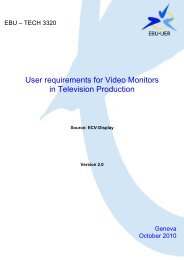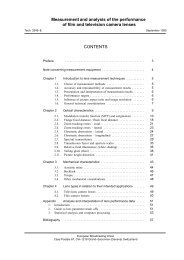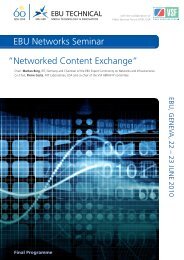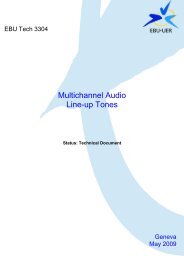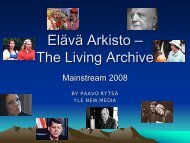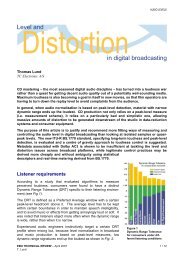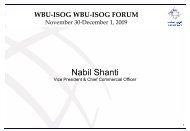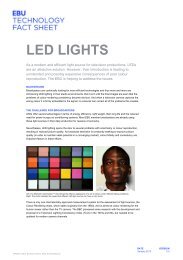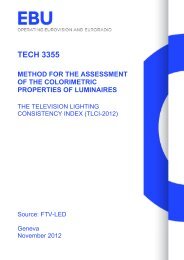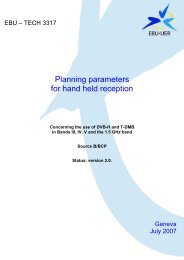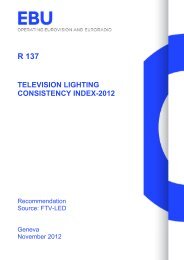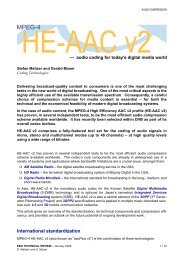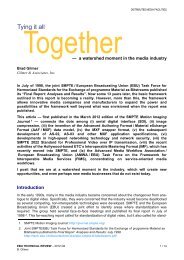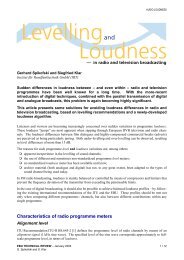Production Technology Seminar 2009 - EBU Technical
Production Technology Seminar 2009 - EBU Technical
Production Technology Seminar 2009 - EBU Technical
Create successful ePaper yourself
Turn your PDF publications into a flip-book with our unique Google optimized e-Paper software.
52<br />
� More, better and structured metadata will be the driver to manage the evolution from bare<br />
application integration to information integration and supply chain optimisation.<br />
A value-added application like the Search engine for video [16] is a bit of a problem, because as long as<br />
we can index video files by crawling the hypertext surrounding it is searchable, but as soon as we put<br />
every piece of video on-line before an editor has added some text we have a major issue because it<br />
does not exist any search engine to index video as such – So that was considered a focal area in our<br />
R&D.<br />
A regular procedure would be to include logging activities during capturing or annotation activities in the<br />
Archives process. We think it is not very scalable and we need to accelerate this type of process [15].<br />
We did a lot of research on computer-assisted archiving and particularly features extraction.<br />
Shot segmentation is an easy one but a more difficult one is scene regognition [17], when you want to<br />
offer a time-coded index of a logical unit of work, which corresponds to the unit of the editor or of a<br />
director.<br />
Another work is video copy detection [18] to identify duplicates, to group related copies or search<br />
results, for Intellectual Property Protection and for computer-assisted analysis.<br />
The work on face detection [19] was not based on the pixels but on morphing 3D models.<br />
All these features extractors would run in the background during ingest. Instead of offering the archivist<br />
an annotation client with which it should start from scratch, we have proposed an annotation client that<br />
collects the preparatory work [20] including all the scripts that have been collected from the editorial<br />
department, if available, including subtitles – that are available from another department. The most<br />
difficult final task of our research project has to integrate these different sources, those different aspects<br />
of the same item, to perform the 'semantic aligning' of all these dimensions.<br />
As a proof of concept, we came up with an advanced Search Engine 'Trouvaille' (lucky find) [21]. It is<br />
optimised for video with a lot of metadata processing going underneath. We include it in our on-line<br />
News bulletin, and we are looking how to re-use the research results in our broadband Internet news<br />
player [22].<br />
Last challenge: starting from CAD/CAM [23], we are wondering if we could apply 3D modelling<br />
technology for pre-visualisation for regular TV drama production, using a very interactive interface, a "3D<br />
set modeler" 45 [27].<br />
3.5 LIVE extends the interactive television experience – The 2008 Beijing Olympic<br />
Games<br />
Philipp Krebs, ORF, Austria<br />
LIVE 46 is an integrated project partially funded under the European Union's IST 6th Framework<br />
Programme. It was launched on January 2006 and will run for 45 months. The coordinator is Fraunhofer<br />
IAIS. The LIVE project creates novel content formats with new production methods and intelligent tools<br />
for interactive digital broadcasters. TV consumers are able to influence the TV authoring of live content.<br />
Professional users are enabled to create a non-linear multi-stream video show in real-time, which<br />
changes due to the interests of the consumer (end user).<br />
The LIVE system and new TV format were tested at ORF (Austrian public broadcaster) during the 2008<br />
Beijing Summer Olympic Games. The LIVE trial went “on air” over the three weekends of the Olympic<br />
Games 9-24 August 2008 from 9am to 3pm on both Saturday and Sunday. The input video sources<br />
were: 12 multi-streams live from the Olympic Games sites, 1 studio mix (3 cameras), 1 live camera for<br />
backstage 'visits' and more than 120 video clips (archives) through 3 parallel channels. The ouput „ORF1<br />
Interaktiv‟ broadcast consisted of 5 interlinked channels [4]. A simple onscreen menu enabled viewers to<br />
45 http://www.vrtmedialab.be/index.php/nederlands/publications/publ_medialab_MV_20080913_ibc2008<br />
46 http://www.ist-live.org http://www.ist-live.org/promo-material/promo-material/factsheet_2008.pdf<br />
© <strong>EBU</strong> <strong>2009</strong> / <strong>Production</strong> <strong>Technology</strong> seminar / January 27 - 29, <strong>2009</strong><br />
Reproduction prohibited without written permission of <strong>EBU</strong> TECHNICAL & <strong>EBU</strong> TRAINING



